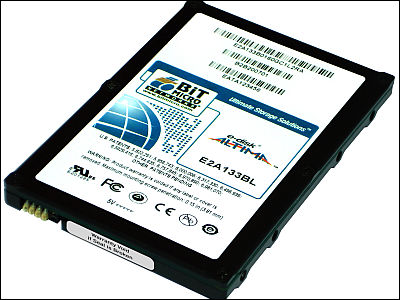What should I look for in order to estimate the lifespan of an SSD?

by
With the advancement of technology, it has become commonplace for SSDs, which are faster to read and write than HDDs, are quieter and have higher shock resistance, to be adopted as the main storage of PCs. However, an SSD that uses flash memory as a storage device has an upper limit on the number of times it can be written, and its life varies depending on how it is used. A blog dealing with Apple-related news The Eclectic Light Company explains the lifespan of SSDs used in Macs.
How to estimate an SSD's working life – The Eclectic Light Company
https://eclecticlight.co/2022/12/05/how-to-estimate-an-ssds-working-life/
HDDs are consumables, but there are individual differences in wear and damage when rotated, and it is difficult to predict when they will break. However, in most cases, SSD failure occurs when the maximum number of read/write cycles is reached, and it is possible to predict it to some extent.
SSDs incorporate wear leveling technology so that all memory degrades at a constant rate. If this system does not function properly, it will be a situation that 'Although the A block is hardly used, the B block is worn out and has reached the end of its life.' In other words, the reliability of SSD can be rephrased as the reliability of wear leveling.
Much of the data stored on SSDs is not updated regularly. Therefore static data must be moved to even out the wear level across all the memory in the SSD. However, this static data movement increases the number of data reads and writes, which accelerates SSD wear.
On macOS, the file system Apple File System (APFS) uses copy-on-write to write to a new block each time it writes a changed block of data instead of trying to write to the same block. This APFS is a useful technology for wear leveling, but it is not a replacement for wear leveling.

by
There are several ways to indicate the useful life of an SSD, but the most widely used is TBW (Total Bytes Written). The manufacturer expresses it as one of the specifications, such as 'This SSD's TBW is 600TB'. For example, if you have written 100 TB to an SSD with a capacity of 1 TB / TBW 600 TB, you can see that the remaining life is 83.3%.
In other words, if you know TBW and DUW (Data Units Written), which is the total amount of data written so far, it is easy to estimate the lifespan of the SSD, that is, the remaining writable amount.
However, the manufacturer's nominal TBW itself is not that reliable, and even the same model of SSD will have different TBW if the production date and line are different. Also, Apple does not disclose the TBW of the SSD built into the Mac. It seems that the TBW of the SSD built into the Mac in recent years is considered to be 600 to 1200 TB in the case of 1 TB, but it can be said that the TBW is an uncertain number for such a wide range. . You can also check DUW with a tool called SMART for SSDs.

by
Since the TBW of an SSD is directly linked to its lifespan, it can generally be said that a higher TBW is better, but depending on the application, there is no problem even if the TBW is low. For example, even if the TDW of a 2TB external SSD used for backup for a year is about 100TB, if the DUW itself is only 5TB, it can theoretically last for 20 years. Higher TBW is desirable for main system storage that is read and written frequently, but not so high TBW for backup.
Also, if you use the memory area that is accessed less frequently in the SSD as the swap area, which is virtual memory, the frequency of reading and writing increases, which shortens the life of the SSD. If TBW writes 30TB per year to a 300TB SSD, the lifetime will be about 10 years, but just securing 10GB of swap space every day will shorten the lifetime by another year or more.

by Ambra Galassi
Finally, The Eclectic Light Company points out that ``Wear leveling is most efficiently done on SSDs with enough free space using APFS'', ``The larger the SSD, the more TBW''. High TBW is not required for backup, but high TBW is required for system storage.'
Related Posts:
in Hardware, Posted by log1i_yk







